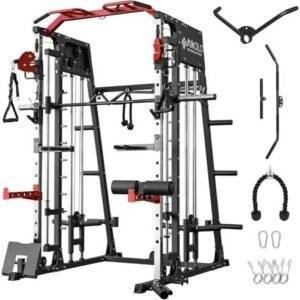In a world that often prioritizes strength and endurance in fitness regimens, flexibility training is a vital yet frequently overlooked component of personal health and athletic performance. As we navigate through our busy lives, the focus tends to center on lifting heavier weights or running faster miles, leaving flexibility as an afterthought. However, the truth is that improving your flexibility can unlock a treasure trove of benefits that not only enhance your physical abilities but also contribute to your overall well-being. From injury prevention and improved posture to better athletic performance and enhanced mental clarity, flexibility training is an essential practise that deserves a prominent place in your fitness routine. In this article, we’ll explore the transformative power of flexibility training, delving into its numerous advantages and practical approaches to incorporate it into your daily life. Whether you’re an experienced athlete or just beginning your fitness journey, understanding how to unlock your potential through flexibility is a step toward a healthier, more vibrant you.
Table of Contents
- Understanding Flexibility and Its Role in Performance
- Key Benefits of Flexibility Training for Overall Health
- Effective Techniques for Incorporating Flexibility Exercises
- Creating a Sustainable Flexibility Routine for Lasting Results
- In Retrospect
Understanding Flexibility and Its Role in Performance
Flexibility is often viewed merely as a physical attribute, but its implications extend far beyond achieving impressive splits or touching your toes. In the realm of performance, flexibility plays a pivotal role in enhancing overall movement efficiency, reducing the risk of injury, and promoting quicker recovery times. A comprehensive flexibility training program can lead to improved muscular balance and joint stability, ensuring that the body responds more effectively during dynamic activities. Incorporating a diverse array of stretching techniques, including static, dynamic, and proprioceptive neuromuscular facilitation (PNF) stretches, can offer significant benefits for athletes and fitness enthusiasts alike.
The connection between flexibility and performance can be illustrated through various factors. For instance, adequate flexibility allows for a more extensive range of motion, which contributes to better technique in sports and physical activities. This means having the ability to achieve positions that optimize performance, whether it’s a deep squat in weightlifting or the perfect lunge in running. Furthermore, flexible muscles are less likely to experience strains or tears, which diminishes downtime from training or competition. To emphasize these advantages, consider the following:
- Enhanced athletic performance – Greater flexibility leads to improved functional movements.
- Injury prevention - Flexible muscles are resilient and adapt better to stress.
- Faster recovery - Improved circulation from stretching helps reduce muscle soreness.
Key Benefits of Flexibility Training for Overall Health
Flexibility training offers a plethora of advantages that extend beyond the mere ability to touch your toes. By incorporating regular stretching and mobility exercises, individuals can experience significant improvements in their overall health. Enhanced range of motion, for example, allows for more efficient movement patterns, which can lead to better performance in daily activities and physical exercise. Additionally, flexibility training plays a crucial role in injury prevention; by keeping muscles and tendons supple, individuals are less likely to face strains and sprains during physical activities.
Moreover, engaging in flexibility routines can positively impact mental well-being. Many flexibility training methods, such as yoga or Pilates, not only focus on physical stretches but also incorporate elements of mindfulness and stress reduction. These practices encourage relaxation and promote a sense of calm, making them effective tools for combating daily stress. Furthermore, consistent flexibility training may improve posture and muscle balance, leading to decreased discomfort and pain, especially in the back and joints. Embracing flexibility as a key component of your fitness regimen can contribute to a holistic approach to a healthier and happier life.
Effective Techniques for Incorporating Flexibility Exercises
Incorporating flexibility exercises into your routine doesn’t have to be daunting. To get started, consider implementing these effective techniques that cater to various fitness levels and can seamlessly blend into your day:
- Dynamic Stretching: Engage in movements that mimic the activities you’ll perform during your workout. Leg swings, arm circles, and torso twists are great warm-up exercises that not only improve flexibility but also enhance mobility.
- Static Stretching: Post-workout is the best time to focus on static stretching. Spend 15-30 seconds holding stretches such as standing quadriceps stretches or seated hamstring stretches to promote muscle recovery and lengthening.
- Incorporate Yoga: Attend a class or follow an online session dedicated to yoga. The combination of breath, movement, and mindful stretching can greatly enhance flexibility over time.
Tracking your progress can be incredibly beneficial. Consider using a simple table to monitor flexibility gains and areas that may need more focus. Here’s a quick overview of recommended stretches, their target muscles, and progress indicators you should note:
| Stretch | Target Muscles | Weekly Frequency |
|---|---|---|
| Standing Quad Stretch | Quadriceps | 3-4 times |
| Seated Forward Bend | Hamstrings, Lower Back | 2-3 times |
| Cat-Cow Stretch | Spinal Flexors | Daily |
Creating a Sustainable Flexibility Routine for Lasting Results
Developing a sustainable flexibility routine involves integrating a variety of techniques that cater to both your physical needs and lifestyle. Consistency is key; aim for short, frequent sessions rather than sporadic, lengthy workouts. This not only helps with long-term adherence but also ensures your body gradually adapts to increased flexibility. Consider the following approaches to enrich your routine:
- Dynamic Stretching: Incorporate movements that mimic your activities to prepare muscles.
- Static Stretching: Focus on holding stretches to gradually improve muscle length.
- Yoga or Pilates: Engage in practices that enhance flexibility through guided movements.
Tracking your progress can also provide motivation and insight into how your body responds. Making it fun can help keep you engaged; consider joining classes or working out with friends. To keep everything organized, here’s a simple table that outlines the frequency, type, and duration of flexibility activities:
| Activity Type | Frequency | Duration |
|---|---|---|
| Dynamic Stretching | Daily | 5-10 minutes |
| Static Stretching | 3 times a week | 10-15 minutes |
| Yoga/Pilates | 2 times a week | 30-60 minutes |
In Retrospect
harnessing the power of flexibility training is not just about enhancing physical performance; it’s a vital component of unlocking your full potential in both fitness and daily life. Embracing flexibility can lead to improved mobility, reduced risk of injury, and a greater sense of well-being. As you embark on your journey to incorporate flexibility training into your routine, remember that consistency and patience are key. Whether you’re a seasoned athlete or just starting out, the benefits of flexibility are universal and accessible to all.
So, why not begin today? Set aside time in your weekly schedule for flexibility exercises, explore various techniques like yoga or dynamic stretching, and listen to your body’s needs. By committing to this practise, you’re not only investing in your physical health but also fostering a resilient mindset that will serve you well in all areas of life.
Unlock your potential—one stretch at a time. Thank you for joining us in exploring the significance of flexibility training, and here’s to a more agile and empowered you!





